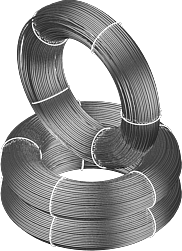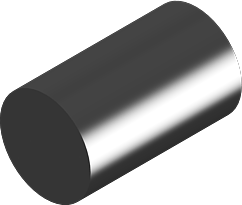Nickel Nimonic 263
View AMS Numbers >
Nickel Nimonic 263
Nickel Nimonic 263 is a nickel-chromium-cobalt-molybdenum alloy. It was developed in 1971 by Rolls-Royce Ltd. as a replacement of Nimonic alloy 80A. It was designed so that it would offer improved ductility in welded assemblies, and to meet specific criteria in terms of proof stress and creep strength.
Suitable both for cold forming and hot forming, the alloy Nimonic 263 is supplied in its annealed condition which provides excellent ductility and excellent fabrication characteristics. Due to its properties, alloy nimonic 263 finds use in high temperature and high strength applications, such as the hot section of gas turbines, both in aircraft and land-based applications.
Tech Steel & Materials offers Nickel Nimonic 263 in 2 sub-type specifications and in multiple shapes/forms:
Chemical Composition of Alloy Nickel Nimonic 263
The composition of the particular alloy is the following:
| Element | Limiting Chemical Composition (%) |
| Carbon | 0.04%-0.08% |
| Silicon | 0.40% max |
| Manganese | 0.60% max |
| Sulfur | 0.007% max |
| Silver | 0.0005% max |
| Aluminum | 0.60% max |
| Boron | 0.005% max |
| Bismuth | 0.0001% max |
| Cobalt | 19.0%-21.0% |
| Chromium | 19.0%-21.0% |
| Copper | 0.20% max |
| Iron | 0.7% max |
| Molybdenum | 5.6%-6.1% |
| Lead | 0.0020% max |
| Titanium | 1.9%-2.4% |
| Aluminum and titanium | 2.4%-2.8% |
| Nickel | Balance* |
*Not exclusively to the element mentioned, but that one predominates other elements that are used only in minimal quantities.
Fabrication and Working Instructions
Nimonic 263 can be hot worked in the temperature range of 1742-2102°F (950-1150°C). Cold forming mechanical properties, on the other hand, are given in the following table:
| 0.1% proof stress | 343 MPa |
| 0.2% proof stress | 355 MPa |
| 0.5% proof stress | 369 MPa |
| Tensile strength | 788 MPa |
| Elongation on 50 mm, % | 59.7 |
| Hardness | 195 HV |
| Mean grain size | ASTM 6.5 |
| Erichsen value | 12.8 mm |
| Shear strength | 588 MPa |
| Ratio of shear to tensile strength | 0.75 |
Please note that the data is obtained using annealed sheet 0.5-1.2 mm thick, using annealing technique of 3 minutes at 1190°C by fluidized bed quenching.
Annealing of Nimonic 263 is required during manipulations with the alloy. The following instructions should be followed regarding the shape or form:
- Bar or heavy section is usually softened by a heat treatment that lasts two hours at 2102°F (1150°C);
- Annealing of sheets should last 15 minutes at a temperature range of 1922-2012°F (1050-1100°C), followed by rapid cooling. For sheets, fluidized bed quenching can also be used.
Depending on the joint configuration and material thickness, Nimonic alloy 263 can be readily welded by argon shielded automatic and manual T.I.G and M.I.G processes. For all argon shielded welding processes the filler metal is the AMS 5966 specification (Nimonic filler metal 263), available here. In the few next bulleted points, you can see all the different argon shielded welding processes:
- Automatic T.I.G. welding can be employed on parts with a thickness of up to 3.25 mm, and only for simple butt joints without any special shaping. The Nimonic filler metal 263 should be used for parts thicker than 1.6 mm, while welding can be obtained without filler metal for parts that are thinner than 1.6 mm;
- Manual T.I.G. welding should be employed on more complicated joints with special shaping and is recommended to be used on thicknesses of up to 4.8 mm;
- I.G. welding can be used on all section thicknesses, but it is best to be used on thicknesses above 4.8 mm. Besides, it should be used over manual T.I.G. if a lot of welding is required. Both spray and dip transfer conditions can be used in this process.
Other welding and joining processes that can be used on Nimonic alloy 263, but to a lesser extent:
- Resistance spot, stitch and seam welding;
- Flash-butt welding used for the manufacture of gas turbine rings.
| Physical Properties | |
| Density | 0.302 lb/in3 |
| 8.36 g/cm3 | |
| Melting Range | Liquidus temperature 2471°F (1355°C) |
| Solidus temperature 2372°F (1300°C) | |
| Specific Heat at J/kg | 862°F (461°C) |
| Mechanical Properties | |
| Tensile strength (precipitation hardened at room temperature) | 940 MPa |
| 136,000 psi | |
| Yield strength (@strain 0.200%, precipitation hardened, value at room temperature) | 550 MPa |
| 79,800 psi | |
| Elongation at break (precipitation hardened) | 39% |
| Thermal Properties | |
| Thermal expansion coefficient at 69.8-212°F (21-100°C) | 5.72 µin/in°F |
| 10.3 µm/m°C | |
| Thermal conductivity | 81.2 BTU in/hr.ft².°F |
| 11.7 W/mK | |
Heat Treatment
Typically, Nimonic alloy 263 should be given a two-stage heat-treatment carried out in the air, or more specifically solution treatment and age hardening. Here are all the details on recommended heat treatments for different forms of the alloy:
- Extruded or forged bars and a section for forging and /or machining – 1.5-2.5h at 2102°F (1150°C)/WQ for solution treatment and 8 h at 1472°F (800°C)/AC for aging treatment;
- Hot rolled sheet – 1.5h at 2102°F (1150°C)/WQ for solution treatment and 8 h at 1472°F (800°C)/AC for aging treatment;
- Cold-rolled sheet and cold-drawn section (including tube) – 3-10 min at 2102°F (1150°C)/FBQ or WQ for solution treatment and 8 h at 1472°F (800°C)/AC for aging treatment.
Select AMS Number:
| AMS Number | Alloy | Type | UNS | Cross Ref. Spec | Misc./Shape | |
|---|---|---|---|---|---|---|
| AMS 5872 Plate | Nimonic 263 | Nickel | N07263 | - | Plate |
 |
| AMS 5872 Sheet | Nimonic 263 | Nickel | N07263 | - | Sheet |
 |
| AMS 5872 Strip | Nimonic 263 | Nickel | N07263 | - | Strip |
 |
| AMS 5966 |
Nimonic 263 | Nickel | N07263 | - | Wire |
 |


 Tech Steel & Materials
Tech Steel & Materials